This was a covid lockdown issue. The stamps were issued on June 25 when Chennai(my home city) was placed under intense lockdown.
India Post decided to honour a category of musicians we rarely see in big-cities by issuing six commemorative se-tenant stamps on wandering minstrels. In Chennai, we are seeing an increase in the number of itinerant soothsayers in the city, but not wandering minstrels.
Wandering minstrels as their name suggest travel from place to place. Their music in its essence captures the cultural elements of their particular region.
The six se-tenant stamps are in the denomination of Rs 5/- each. The stamps named after their respective instruments are as follows:
1.Commemorative Se-tenant stamp on Surando
The Surando is an ancient folk musical instrument of Kutch. The Surando is a stringed musical instrument played with the use of a bow (it is called Gaz or Gazi in the local dialect). Ideally, the Surando is made out of Lahirro wood. However, Talhi, Bahan, and Mango wood can be used, in the order of importance as written. The bow or gaz is comprised of strings of horse’s hair or gut fastened to each of a flexible stick. The bow is placed on the strings at right angles to it and is moved back and forth across it. Producing sound with the help of the bow in friction with the strings is a more advanced skill than plucking. Strings are tuned to a proper frequency by tuning the pegs on the instruments.

A Surando has six strings – five are made of steel and the sixth is made of copper and each strings has a specific name eg. Agor,Tip,Jara etc. The Surando is a chordophone. I have not heard the Surando.
2.Commemorative Se-tenant stamp on Ravanahatha
The Ravanahatha is a stringed musical instrument It is said that the ravanahatha is the precursor to the violin.
The Ravanahatha made up of locally available materials like bamboo, metal pipes and strings, coconut shell, leather, and horse’s hair. An 80-90cm long bamboo stem makes up the foundation of a Ravanahatha .To the end of it half a coconut shell is attached. To make the shell more vibration-proof, it is covered by goat hide. The stem itself is punctured at regular interval to fix the knobs which will later help in fine-tuning the music. The exclusive part of the instrument is the Bejara (friction-reducing powder cake) smoothed hair from horsetail, which makes the sound produced by the instrument unique. The Ravanahatha is played like a violin.
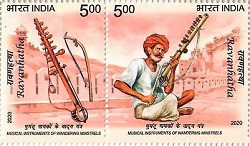
It includes a bow that is drawn across the strings to create musical vibrations. It also has a fingerboard which is used to play the octaves. The ravanahatha is a chordophone. To my knowledge, the ravanahatha is very common among the Gypsies of Rajasthan.
3.Commemorative Se-tenant stamp on Ektara
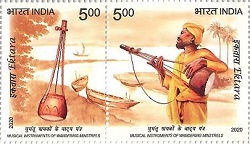
The Ektara is a one-stringed musical instrument common in India, Pakistan, and Bangladesh. It is a string instrument. It is commonly used in religious ceremonies.
The ektara is a drone lute consisting of a gourd resonator covered with skin, through which a bamboo neck is inserted.
4.Commemorative Se-tenant stamp on Algoza
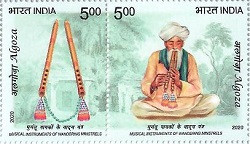
TheAlgoza is a double fluted woodwind instrument used by folk musicians of India and Pakistan.
It consists of two joined beak flutes, one for drone, the other for melody.
Alas, I have not heard this beautiful instrument.
5.Commemorative Se-tenant stamp on Burrakatha Dakki
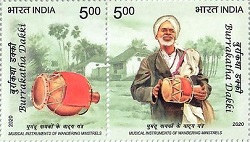
The Burrakatha Dakki is a membranophone. It is native to Andhra Pradesh and Telangana. It is a pitcher shaped brass vessel which has a short-neck and round belly. It is suspended from the neck and played by hands.
6.Commemorative Se-tenant stamp on Kamaicha
For this section, I am re-producing an article from the Hindu
The link is: https://www.thehindu.com/entertainment/music/why-manganiyars-love-the-kamaicha/article22761362.ece
The article beautifully describes the Kamaicha. The authors are classical Indian musicians.
Quote<<Why Manganiyars love the Kamaicha
The instrument lends vibrancy to their music
We were once at IIT Jodhpur for the International Workshop on Art, Culture and Heritage to present a paper on ‘Synthesizing Creative Spaces – From the Aesthetic to the Scientific’. During that time, we were taken on a tour of the city and visited the Mandore Fort, Mandore gardens that houses the government museum, the Hall of Heroes, and the temple of 33 crore gods, apart from the Ravan temple (in Mandore) — believed to be the birth place of Mandodari, the queen consort of King Ravana. At the fort, we were welcomed by the Manganiyars, who are Rajasthani folk musicians.
The bowed instrument they played is called Kamaicha that is synonymous with the Manganiyar community. Heard more in the Jaisalmer-Barmer region, it accompanies solo or group performances of singing and dancing. By playing the open strings, the instrument can also produce a drone effect. Sometimes during solo performances, the Kamaicha artiste sings and plays the instrument.
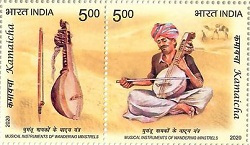
Songs for occasions
During a song, the interludes are performed on the Kamaicha. The Manganiyars sing and play songs for specific occasions such as weddings or births, apart from accompanying stories of renowned heroes and lovers. These folk melodies have been passed on from generation to generation. Devotional songs and Sufi music are also part of their repertoire now.
Though the Manganiars are Muslim musicians by birth, yet their lifestyle reflects the Hindu culture. They celebrate Hindu festivals such as Diwali and Holi. Many of the songs they render are in praise of the various Hindu deities.
The old records state that the Manganiyars are also referred to as the Merasi. Apparently, the Merasis played the Kamaicha to entertain the royals for many generations and were musicians at the Rajput courts.
Kamaicha belongs to the category of the chorodophones. Its body is carved from a single piece of wood belonging to a seasoned mango tree. The basic structure is first carved out by the master craftsman.
The round, big belly is the resonator, spherical in shape. It produces a warm tone and is covered with goat skin. This extends to the neck and the fingerboard. An ivory strip is fixed over the wood of the neck to protect it from getting worn out due to the sliding of the left hand fingers. In the fingerboard, which is fretless, are embedded pearl studs in the shape of flowers as an embellishment.
Kamaicha consists of 17 strings, of which three are the main ones. They are prepared from the goat’s intestine called Roda and Joda. The other 14 strings are called Jhara, out of which five are made of copper while the rest are made of steel wire. The main strings are thicker compared to the sympathetic strings. These strings pass over a thin bridge, which is long and made from the sheesham wood. The strings are tied to the pegs. The sympathetic strings are placed along with the main ones. The performer produces the rhythmic effects on these strings. The pitch of the string is sometimes changed by rubbing the finger nails against the string. Occasionally the strings are pulled too. Three fingers of the left hand – the index, middle and the ring fingers – play the notes and the finger nails are used for sliding.
The stick portion of the bow is made from the Khejari wood and the hair from the tail of the horse. The bow is concave in shape. The thumb, index and the middle fingers of the right hand hold the stick portion of the bow while the ring finger goes inside the stick. Mainly, the long bows are used to perform than the short bow strokes. The instrument is kept upright and played.
Kamaicha plays a crucial role in the vibrant music of the Manganiyars.>.Unquote.
If you collect se-tenant stamps or stamps on music, you must have these stamps in your collection.
